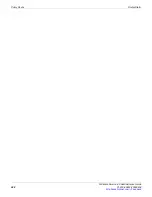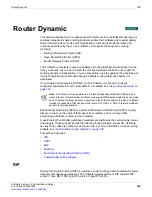
Router Static
Policy Route
FortiGate Version 4.0 Administration Guide
01-400-89802-20090424
287
•
Moving a policy route
A routing policy is added to the bottom of the routing table when it is created. If you prefer
to use one policy over another, you may want to move it to a different location in the
routing policy table.
The option to use one of two routes happens when both routes are a match, for example
172.20.0.0/255.255.0.0
and
172.20.120.0/255.255.255.0
. If both of these
routes are in the policy table, both can match a route to
172.20.120.112
but you
consider the second one as a better match. In that case the best match route should be
positioned before the other route in the policy table.
In the case of two matches in the routing table, alternating sessions will use both routes in
a load balancing configuration. You can also manually assign priorities to routes. For two
matches in the routing table, the priority will determine which route is used. This feature is
available only through the CLI. For details, see
To change the position of a policy route in the table, go to
Router > Static > Policy Route
and select
Move To
for the policy route you want to move.
Figure 169: Moving a policy route
Source Address /
Mask
To perform policy routing based on the IP source address of the packet, type
the source address and network mask to match. A value of
0.0.0.0/0.0.0.0
disables the feature.
Destination
Address / Mask
To perform policy routing based on the IP destination address of the packet,
type the destination address and network mask to match. A value of
0.0.0.0/0.0.0.0
disables the feature.
Destination Ports
To perform policy routing based on the port on which the packet is received,
type the same port number in the From and To fields. To apply policy routing
to a range of ports, type the starting port number in the From field and the
ending port number in the To field. A value of 0 disables this feature.
The Destination Ports fields are only used for TCP and UDP protocols. The
ports are skipped over for all other protocols.
Type of Service
Use a two digit hexadecimal bit pattern to match to define the service, or use
a two digit hexadecimal bit mask to mask out.
For example if you want the policy to apply to service 14 you would use a bit
pattern of 0E. If you wanted to ignore all odd numbered services you would
use a bit mask of 01.
Outgoing Interface
Select the name of the interface through which packets affected by the policy
will be routed.
Gateway Address
Type the IP address of the next-hop router that the FortiGate unit can access
through the specified interface. A value of
0.0.0.0
is not valid.
Before/After
Select Before to place the selected Policy Route before the indicated route.
Select After to place it following the indicated route.
Policy route ID
Enter the Policy route ID of the route in the Policy route table to move the
selected route before or after.
Summary of Contents for Gate 60D
Page 705: ...www fortinet com...
Page 706: ...www fortinet com...






























